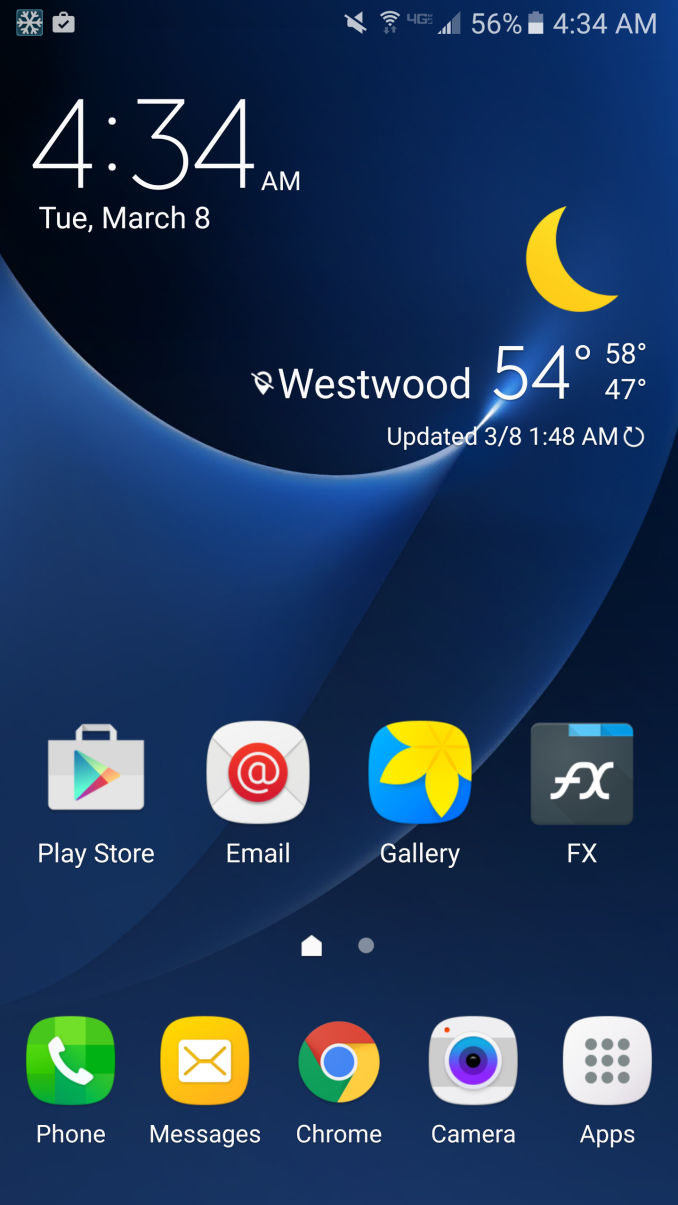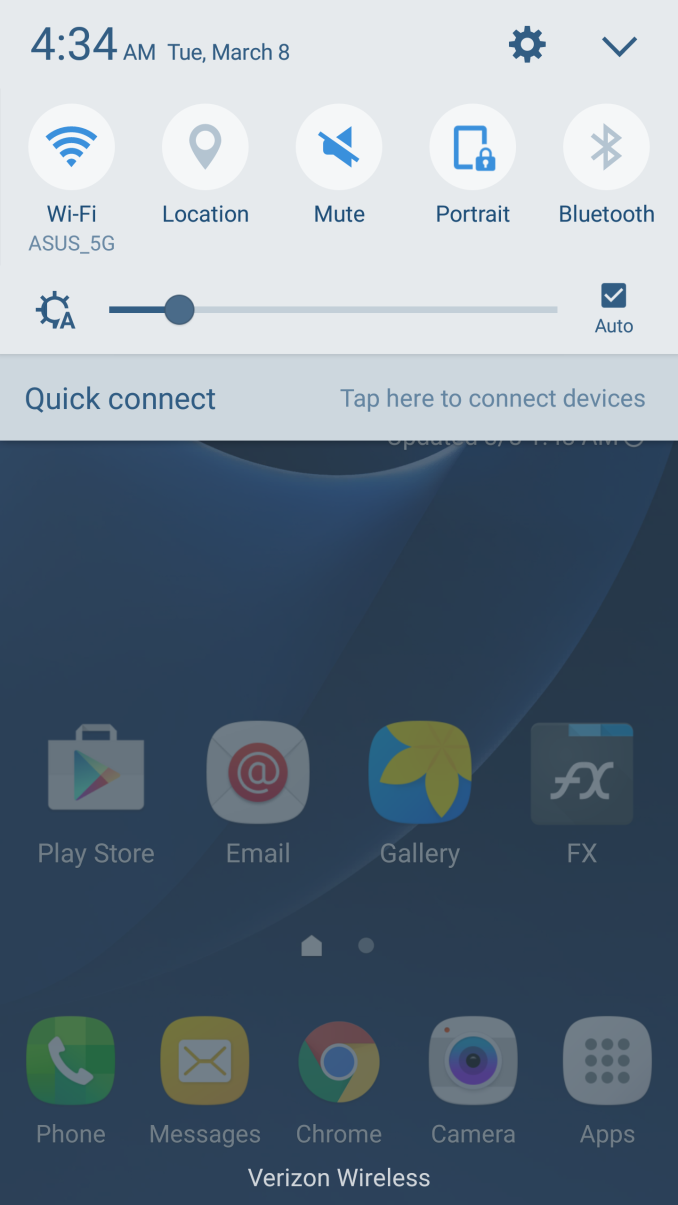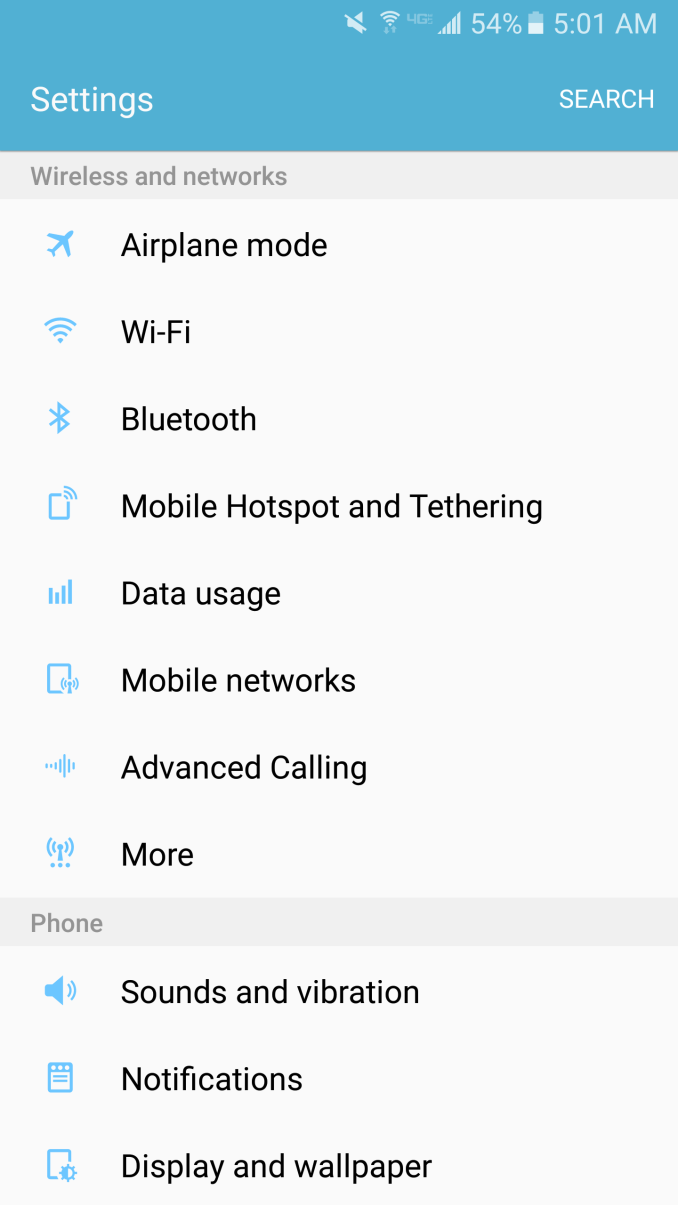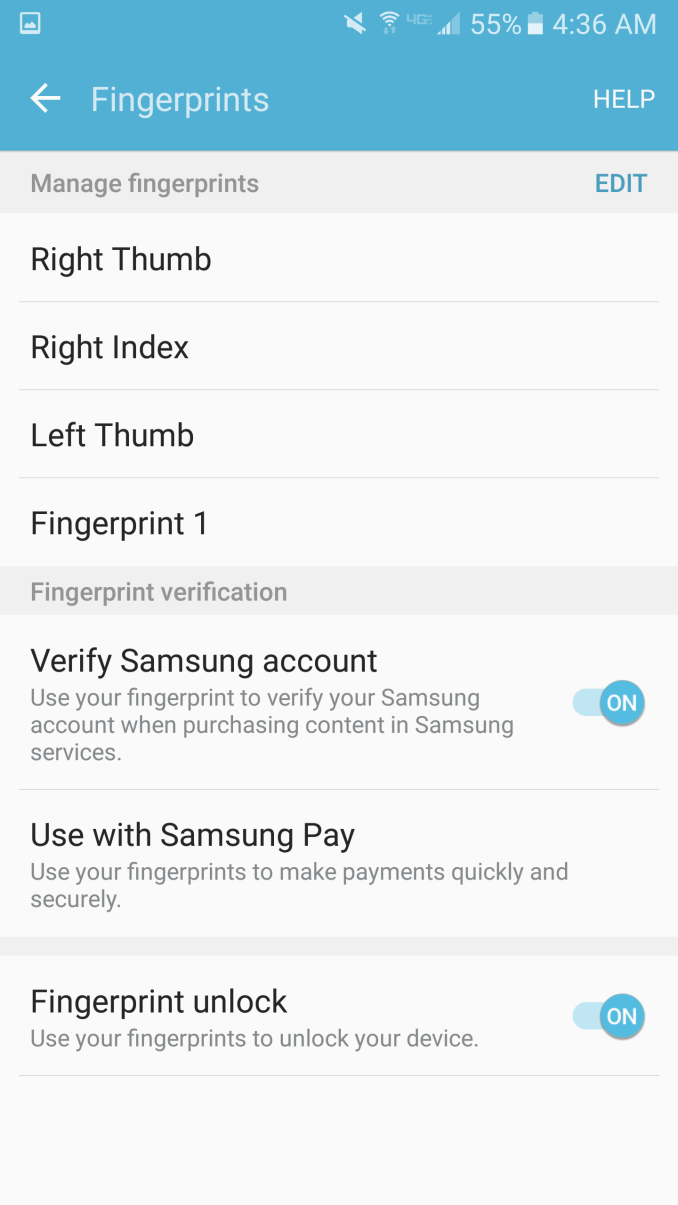The Samsung Galaxy S7 & S7 Edge Review, Part 1
by Joshua Ho on March 8, 2016 9:00 AM ESTSoftware UX
As is always the case, there’s a perpetual debate over the role of the OEM when it comes to Android devices. For better or worse, Samsung seems to believe that they need to add their own framework and UI over Android. To some extent, I suspect that most users are going to find stock Android to be rather spartan out of the box, so it does make sense for OEMs like Samsung to continue adding their own custom applications and frameworks to help differentiate themselves from the competition.
With the Galaxy S5, it was evident that Samsung had dramatically changed their design direction for TouchWiz, but I would argue that their design aesthetic still wasn’t quite perfect, and performance wasn’t completely there either. With the Galaxy S6, Samsung had gotten closer to the mark in some ways, but the continued use of excessively neon colors just made parts of the UI feel off at times, and performance still wasn’t perfect.
With the Galaxy S7, performance has improved noticeably, but it’s really hard for me to say whether this is because Samsung has improved their codebase, or if a faster SoC is just making it harder to notice areas in need of optimization. At any rate, while the Galaxy S7 isn’t perfectly smooth - dropping frames now and then - it is sufficiently performant that you’re not going to find distracting lag.
The default theme of the Galaxy S7 continues to feel pretty similar to the Galaxy S6, so for the most part things are acceptable here, but the use of color is still a bit excessive as a number of icons still use neon colors rather than more neutral pastel colors. Of course, the theme store now has a number of Material Design themes, which greatly improve the situation. I installed one pretty much immediately, which helps make the device feel a lot better in everyday use. However, I’m still of the opinion that this is something that a user shouldn’t need to do out of the box, so this is an area where Samsung can improve.
The other features that Samsung touted for the Galaxy S7 are interesting, but I’m not really sure they’re all that well executed. Always-On Display is nice to have, but for some reason it's quite reluctant to turn off the display when the ambient light sensor and proximity sensor are covered. As a result I turned it off as it’s clearly going to be contributing to idle battery drain in situations where it shouldn’t.
I also found that the fingerprint scanner is pretty much identical to the one in the Galaxy S6, which isn’t entirely surprising as both identify themselves as a Synaptics fingerprint scanner. Both still seem to be quite sensitive to the initial training period and in my experience won’t really work all that well if you don’t cover your entire fingerprint effectively during that period.
Other than this, TouchWiz doesn’t really stand out in any way as of now. Of course, Samsung Pay will be interesting for me to try as I still regularly run into terminals that don’t support NFC in any shape or form, but I haven’t really been able to spend much time testing Samsung Pay yet. I don’t really find TouchWiz to be a bad thing at this point, but I’m not really sure it’s a good thing either. With a serious emphasis on optimization and a major aesthetic overhaul, it’s entirely possible that I could find myself saying quite differently in the near future, but for now if you found the Galaxy S6 and Note 5 OEM UIs to be usable you’ll find the Galaxy S7 to be usable as well.















202 Comments
View All Comments
ah06 - Tuesday, March 8, 2016 - link
Samsung's core is already done I think, its the Mongoose core in the 8890, the one in the international variants. It's a slightly weaker core than KryoSpeedfriend - Tuesday, March 8, 2016 - link
A7 to A8 tock was 15%, and that was partly higher clock speed in a bigger body. Will be interesting to see what this tock brings.lilmoe - Tuesday, March 8, 2016 - link
Unlike what most reviewers want to believe, when designing application processor cores, companies like ARM, Qualcomm and Samsung aim for a "sweet spot" of load-to-efficiency ratios, not MAX single threaded performance.Their benchmark is common Android workloads (which btw, rarely saturates a Cortex A57 at 1.8GHz), since it's what makes the vast majority of the mobile application processor market. They measure the average/mean workload needs and optimize efficiency for that.
Android isn't as efficient as iOS and Windows Phone/10 Mobile in hardware acceleration and GPU compositing; it's much more CPU bound. It doesn't benefit as much from race to sleep in mobile devices. CPU cores remain significantly more active when rendering various aspects of the UI and scrolling.
tuxRoller - Tuesday, March 8, 2016 - link
Can you explain how you measure the relative "efficiencies" of the "hardware acceleration and GPU compositing"?lilmoe - Wednesday, March 9, 2016 - link
By measuring CPU and RAM utilization when performing said tasks. More efficient implementations would offload more of the work to dedicated co-processors, (in this case, the GPU) and would use less RAM.Generally, the more CPU utilization you need for these tasks, the less efficient the implementation. Android uses more CPU power and more RAM for basic UI rendering than iOS and WP/10M.
tuxRoller - Saturday, March 12, 2016 - link
How do you measure this so that you can ignore differences in the system (like textures chosen)? Then you'd have to make sure they're running on the same hardware.The best you can do is probably test Android and Windows on the same phone (this will put Windows at a bit of a disadvantage as Android allows very close coupling of drivers as their HAL is pretty permissive). Then you run a native game on each.
If you've found a way to do this I, and Google, would love to see the results.
Other than for 2d (which NOBODY, including directdraw/2d or quartz, fully accelerates), Google really hammers the GPU through use of shared memory, overlays and whatever else may be of use. There's obviously more optimization for them to do as they still overdraw WAY too much on certain apps, and they've obviously got a serious issue with their input latency, but it's a modern system. Probably the most modern as its been developed from scratch most recently.
Dobson123 - Tuesday, March 8, 2016 - link
In the 2016 web browsing battery life test, the S6 Edge is 20% worse than the S6, and the LG G4's number is also way too low.lilmoe - Tuesday, March 8, 2016 - link
I also thought the difference in battery life between the S6 and S6 Edge was off. They either posted wrong data, or something wrong happened while testing.MonkeyPaw - Tuesday, March 8, 2016 - link
I'd agree. When one of the phones goes from being upper middle of the pack on the old benchmark to being dead last--and woefully so--then I would have to wonder if something is really wrong with the new test. I've used the G4 for 6 months and have rarely had battery concerns over a day of "regular" use. I've owned several phones, and the G4 is a trooper.Ryan Smith - Tuesday, March 8, 2016 - link
We're re-checking the S6 Edge. We've had issues before with that specific phone.